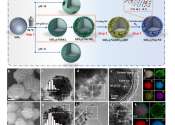Nickel ( /ˈnɪkəl/) is a chemical element with the chemical symbol Ni and atomic number 28. It is a silvery-white lustrous metal with a slight golden tinge. Nickel belongs to the transition metals and is hard and ductile. Pure nickel shows a significant chemical activity, though larger pieces of the metal are slow to react with air at ambient conditions due to the formation of a protective oxide surface. However, nickel is reactive with oxygen to the extent that native nickel is rare on Earth's surface, and is mostly confined to the interiors of larger nickel iron meteorites, which were protected from oxidation in space. Such native nickel is always found on Earth alloyed with iron, in keeping with the element's origin as a major end-product of the nucleosynthesis process, along with iron, in supernovas. An iron-nickel alloy is thought to compose the Earth's core.
The use of nickel (as a natural meteoric nickel-iron alloy) has been traced as far back as 3500 BC. Nickel was first isolated and classified as a chemical element in 1751 by Axel Fredrik Cronstedt, who initially mistook its ore for a copper mineral. Its most important ore minerals are laterites, including limonite, garnierite, and pentlandite. Major production sites include Sudbury region in Canada (which is thought to be of meteoric origin), New Caledonia and Norilsk in Russia.
Because of nickel's slow rate of oxidation at room temperature, it is considered corrosion-resistant. Historically this has led to its use for plating metals such as iron and brass, to its use for chemical apparatus, and its use in certain alloys that will retain a high silvery polish, such as German silver. About 6% of world nickel production is still used for corrosion-resistant pure-nickel plating. Nickel was once a common component of coins, but has largely been replaced by cheaper iron for this purpose, especially since the metal has proven to be a skin allergen for some people.
Nickel is one of the four elements that are ferromagnetic around room temperature. Alnico permanent magnets based partly on nickel are of intermediate strength between iron-based permanent magnets and rare earth magnets. The metal is chiefly valuable in the modern world for the alloys it forms; about 60% of world production is used in nickel-steels (particularly stainless steel). Other common alloys, as well as some new superalloys, make up most of the remainder of world nickel use, with chemical uses for nickel compounds consuming less than 3% of production. As a compound, nickel has a number of niche chemical manufacturing uses, such as a catalyst for hydrogenation. Enzymes of some microorganisms and plants contain nickel as an active center, which makes the metal an essential nutrient for them.









